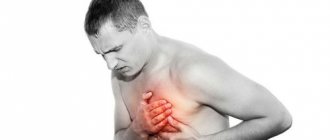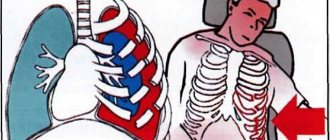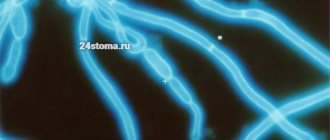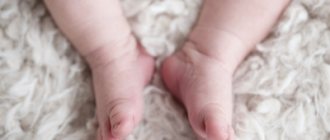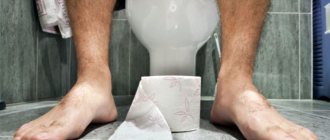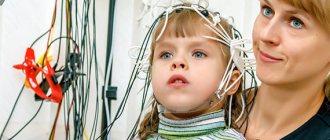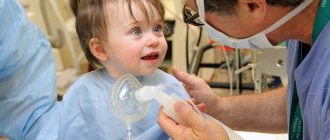Congenital chest deformities in children
Congenital deformity of the chest in children may be associated with genetic characteristics and changes in the formation of the sternocostal complex, which can lead to a gradual increase in deformity until the growth of the child’s or adolescent’s skeleton is completed.
Congenital pathology is associated with improper development of the skeleton (vertebral column, ribs) due to an imbalance of mineral and endocrine metabolism. The consequence may be a specific development of the body:
- painful thinness;
- narrow shoulders;
- high growth;
- protrusion of the shoulder blades and collarbone;
- sunken chest when inhaling;
- long limbs;
- curvature of the spine (scoliosis or kyphosis).
Hereditary deformity is determined in 20-65% of cases of chest deformity. There are diseases and specific syndromes where this type of deformation is one of the symptoms. For example, pathology often develops against the background of Marfan syndrome.
Marfan syndrome
This disease is characterized by funnel-shaped and keeled deformities of the chest.
Marfan syndrome has the following symptoms:
- asthenic physique;
- arachnodactyly;
- dissecting aortic aneurysm;
- dislocation or subluxation of the lenses of the eyes (or other vision pathology);
- biochemical changes in the metabolism of collagen and glycosaminoglycans.
The development of chest deformity can be facilitated by dysplasia of connective and cartilaginous tissues, which is caused by enzymatic disorders.
Sporadic (non-hereditary) forms of deformity
Non-hereditary deformity of the chest develops due to teratogenic factors that affect the fetus during its development. Most often, abnormal development is caused by asynchronous, inharmonious growth of the sternum and costal cartilages.
Symptoms
External changes. In most cases (92% of all congenital deformities), children have a funnel-shaped pathology of the sternum, which is characterized by inadequate development of the costal cartilages, resulting in the formation of a depression in the lower or middle zone of the chest. The sternum is significantly enlarged in the transverse direction. As the child's body grows and develops, the disease becomes more pronounced. As the ribs grow, the chest cavity clearly decreases, which, in turn, irreversibly leads to curvature of the spine and disruption of the cardiovascular system and lungs. In newborn babies, this pathology is mild and becomes more pronounced at the age of three. When inhaling, periodic sinking of the ribs is noted, and paradoxical breathing intensifies, which leads to the development of respiratory failure. Compared to their peers, children lag behind in their physical development, are susceptible to colds and vegetative disorders, and quickly get tired when playing sports or physical activity. In the case of deformation of the upper or middle part of the chest, a scaphoid depression is noted, in which motor functions may be impaired.
Acquired chest deformities
Acquired chest deformity in a child develops against the background of diseases of the lungs and ribs (including tumor-like formations). This pathology can lead to other disorders of the body, for example, improper functioning of the respiratory system or psychological problems.
The acquired deformity is characterized by weakened immunity; the child often suffers from acute respiratory viral infections.
Physiological development is inhibited, fatigue appears after weak physical exertion. There are sharp changes in blood pressure.
Acquired curvature of the chest in a child can develop after suffering musculoskeletal diseases:
- Tuberculosis;
- Rickets;
- Scoliosis (Taking into account the fact that the spine and the sternocostal complex are an interconnected system, with severe deformities of the spine, a pronounced deformation of the chest is sometimes observed. More often, the posterior chest wall is deformed in the form of a rib hump, but there are also accompanying deformities of the anterior chest wall);
- Costal osteomyelitis;
- Rib tumors.
Pathology can be provoked by purulent-inflammatory processes in the soft tissues of the chest walls and pleura, injuries and burns of the chest. In some cases, the deformity is a consequence of cardiac surgery after median sternotomy, which can change the growth of the sternum in a child.
Diagnostics
The development of deformation is easily determined by a specialist based on many external signs. Instrumental diagnostics include methods such as radiography, which allows us to identify the type of pathology and the degree of its development. Computed tomography reveals bone defects, compression of the lungs, mediastinal displacement, as well as the degree of development of the disease. And with the help of magnetic resonance imaging, you can obtain extensive information regarding abnormalities in soft and bone tissues. If there is a suspicion of a disturbance in the functioning of the lungs and heart, then echocardiography, cardiac monitoring using the Holter method, X-ray of the lungs and other studies are performed.
Types of chest deformation
Ryzhikov Dmitry Vladimirovich
Ryzhikov Dmitry Vladimirovich (Head of the Department of General Bone Pathology of the Federal State Budgetary Institution "National Medical Research Center for Pediatric Traumatology and Orthopedics named after G.I. Turner, Candidate of Medical Sciences, doctor of the highest qualification category, traumatologist-orthopedist)By type, we most often see the corpo-costal type, this is a deformation of the sternum in the lower part with the involvement of the ribs.
The manubrial type (manubrio-costal) is much less common, this type includes deformation of the manubrium of the sternum (this is the upper part of this bone).
Orthopedists also differentiate between asymmetric forms of deformation and its elasticity.
At what age and by what symptoms can chest deformation be detected in a child?
Among the patients of our Center there are children of any age. Most patients are admitted with a congenital form of the pathology. Sometimes a child is born with an already noticeable chest deformity, but most often we see situations where the deformation becomes noticeable for the first time at the age of 6-8 years and progresses significantly at 10-13 years. Chest deformities can increase while there is potential for skeletal growth, that is, on average until 15-17 years of age. And the higher the height of the parents and the more active the growth of the children, the higher the risk of developing a very pronounced deformity. In contrast to limb deformities, chest deformities often include in their list of symptoms and disturbances in the functioning of the chest organs.
Kinds.
- Funnel-shaped deformation of the HA.
- Keeled deformity of the HA.
- Developmental anomalies of the ribs and sternum (aplasia and hypoplasia).
- Genetic diseases (Marfan, Ehlers-Danlos, Turner syndromes, etc.). Their symptom complex includes musculoskeletal pathology, including HA deformation.
The most common are the first two in a ratio of 10:1. About 30 theories of the occurrence of these deformations are described in the literature.
Basic theories of the occurrence of these deformations.
- Anomalies of intrauterine development: delayed tissue growth, disruption of the process of normal tissue fusion during the period of 6-9 weeks, disruption of tissue differentiation (various dysplasias): cleft sternum, fusions and defects of the ribs, abnormalities of the pectoral muscles.
- Metabolic enzymopathies associated with disruption of the synthesis of glycosaminoglycans, which leads to disruption of the formation and development of connective tissues.
- Anomaly of the diaphragm (underdevelopment of its anterior sections).
Funnel-shaped deformation of the HA.
VGK is a deformation of the HA, characterized by depression of its middle part and epigastric region. The area of greatest retraction occurs on the body of the sternum and the xiphoid process. The deformity extends to the entire cartilaginous part of the ribs, and in children over 10 years of age it also affects the bone part.
Classification according to V.N. Kondrashin.
Shape: Regular and funnel-shaped.
By type of deformation: symmetrical and asymmetrical (left- and right-sided).
According to the degree (depth) of deformation:
I degree 0.7-1. II degree 0.7-0.5. III degree less than 0.5.
The degree of deformation is determined by radiography performed in a lateral projection. The radiograph measures the shortest and greatest distance from the posterior surface of the sternum to the anterior surface of the thoracic vertebral bodies.
Deformation degree = smallest distance/largest distance.
According to the stage of the disease: compensated, subcompensated, decompensated.
Clinic.
In the compensation stage, VGK appears only as a cosmetic defect. There are no functional disorders of the respiratory and cardiovascular systems. Physical activity is well tolerated. In the subcompensation stage, moderately expressed functional disorders of the respiratory and cardiovascular systems are added. Physical activity is poorly tolerated, there is discomfort in the projection of the heart and paradoxical breathing associated with abnormalities of the diaphragm. Paradoxical breathing disrupts GC excursion and reduces pulmonary ventilation, which leads to functional disorders in the pulmonary circulation due to chronic hypoxemia and the occurrence of frequent bronchopulmonary diseases.
In the stage of decompensation, the deformation of the HA is pronounced, and significant functional disorders of the cardiovascular and respiratory systems are noted.
Treatment.
Surgical treatment for grades 2 and 3 deformity. The optimal age is 5-7 years because...
- Better results due to unfinished skeletal formation.
- Absence of significant functional disorders and secondary deformations of the HA and spine.
- Easier execution technique.
- Smoother postoperative course.
Various options for thoracoplasty are used. Today, more than 30 methods and their modifications are known.
Keeled chest deformity.
KGC is a deformity of the sternum, characterized by a noticeable protrusion of the sternum, horizontal arrangement of the ribs, an increase in the anteroposterior size of the sternum, and the formation of a sternocostal hump. In the first three years of life, the deformation is subtle and rarely detected. During periods of growth, the correct development of the HA structures is disrupted and the deformation becomes clearly visible.
Classification according to G.A. Bairov and A.A. Fokin.
- Manubriocostal type.
- Corporacostal type.
- Costal type.
The second type is much more common.
Clinic.
The manubriocostal type is characterized by forward protrusion of the manubrium and the upper part of the body of the sternum, 2-3 costal cartilages. Corporacostal type . Depending on the shape of the sternum (straight, convex, convex), the size of the angle at the junction of the ribs with the sternum, the degree of deflection of 5-10 ribs, 4 forms of CGC are distinguished: linear, round, pyramidal and trapezoidal. The ribs in the cranial part run more horizontally. At the level of the sternum, the costal cartilages rise vertically, descend in a groove-like manner, or protrude forward in a ridge-like manner. The round shape is characterized by a greater bend in its middle part or middle and lower part. With a pyramidal shape, the sternum with deformed ribs is directed obliquely downwards and anteriorly in a straight line from the manubrium to the xiphoid process. In dynamics, a transition from a round shape to a pyramidal one is possible. The described types of HA are symmetrical and asymmetrical. The costal type is characterized by lateral protrusion of the GC due to excessive growth of the ribs on one side. The sternum can rotate in the direction opposite to the deformity. The ribs on the healthy side are either not deformed or sunken. In children under 10 years of age, functional impairments are mild. After 10 years, a decrease in vital capacity is observed, and the minute volume of respiration increases (the volume of air inhaled in 1 minute). Functional disorders of the heart are noted.
Treatment.
Operative for all types. The optimal age is 10-13 years. Various types of thoracoplasty are used.
Flat chest.
PCH is a deviation from the normal shape of the sternocostal complex, flattened in the anteroposterior direction. Classification according to Wolanski.
Three degrees of flattening : somewhat flattened HA, flat HA and excessively flat HA.
Treatment.
- Physiotherapy. Breathing exercises.
- Strengthening the muscles of the back and shoulder girdle.
- Swimming.
- In some cases, thoracoplasty.
The article was prepared by an orthopedic doctor at the Tiger Cub children's clinic, Pavel Vyacheslavovich Kravchenkov
Unique treatment methods at the G.I. Turner National Medical Research Center
Vissarionov Sergey Valentinovich
Vissarionov Sergey Valentinovich (Director of the G.I. Turner National Medical Research Center for Pediatric Traumatology and Orthopedics of the Ministry of Health of Russia, Doctor of Medical Sciences, Professor, Corresponding Member of the Russian Academy of Sciences, laureate of the Government of the Russian Federation)Today, our Center is one of the few that performs unique operations to eliminate pectus excavatum deformity in children (PCD) through the use of low-traumatic methods of surgical correction. In some situations, we can treat keeled chest deformities in children conservatively by using special braces developed in our Center to correct this pathological condition.
The treatment of chest deformities in children and adolescents is carried out by the General Bone Pathology Clinic of our center.
- Conservative methods and surgical treatment of chest pathology
How to get treatment at the Turner Center for Pediatric Traumatology and Orthopedics (formerly the G.I. Turner Research Children's Orthopedic Institute)
The decision on the possibility and necessity of hospitalization at the National Medical Research Center clinic is made after consultation with a specialist from the specialized department and consideration by the Subcommittee of the Medical Commission of the Center for Patient Selection.
For those patients who cannot come for an in-person consultation, there are 2 options:
- Contact a doctor at your place of residence and request a telemedicine consultation in the doctor/doctor mode.
- Send a request for an absentee consultation, attaching all necessary documents. Including a scan of the attending physician's report. It is important for the doctor to obtain information on the form of the deformity (photos of the chest on the right and left are required), it is also important to send data on the FUNCTION OF THE HEART AND LUNG (ECG, echo-kg, spirography)
Human evolution (anthropogenesis)
Factors of human evolution
Biological factors dominated the early stages of human evolution
evolution - variability, struggle for existence, natural selection, etc.
, social factors became the main ones
evolution - social way of life, use of tools, use of fire, development of speech.
Stages of human evolution
| Stage name (specific findings) | life time (years ago), species name | brain volume (ml), tools | what they knew how to do |
| Late stage of Australopithecus | 2.8-2.0 million people skilled | 600-700 pointed pebbles | made and used tools |
| The most ancient man (Pithecanthropus, Sinanthropus, Heidelberg man) | 1.9-0.5 million homo erectus | 800-1100 hewn flints (chopped and scraped) | used and maintained fire, the rudiments of speech appeared |
| Ancient man (Neanderthal) | 300-30 thousand Homo sapiens (Neanderthal subspecies) | 1200-1400 stone scrapers, points, knives | could make fire, collective hunting, ritual burials |
| Modern man (Cro-Magnon) | 35 thousand reasonable people | 1200-1600 knives, spears, stone needles, horns, bones | sewed clothes, built houses, developed agriculture, primitive art |
Races
These are divisions within a species, adapted to specific conditions. All widespread species have races. In humans, there are 3 large races (Negroids, Caucasians, Mongoloids).
Racist theory (racism)
rejects the unity of human races, i.e. states that different races of man are descended from different ancestors. This is not true, all human races easily interbreed and produce fertile offspring, i.e. belong to the same species.
Differences between humans and apes
1) Speech
, chin protuberance.
2) Second signaling system
, large brain, the cerebral part of the skull is larger than the facial part.
3) Labor activity
(creation and use of tools), the thumb of the hand is opposed to the rest and is well developed.
4) Upright walking
: arched foot, widened pelvis, curves in the spine (S-shaped spine), chest expanded to the sides.
You can also read
DETAILED SUMMARY: Stages of human evolution, Factors in human evolution, Similarities and differences between humans and apes
ASSIGNMENTS OF PART 2 OF THE USE ON THIS TOPIC
Part 1 tasks
Choose one, the most correct option. The basis of racial theory is denial
1) similarities between humans and anthropoids 2) unity of origin of human races 3) human belonging to primates 4) morphological unity of races
Answer
2
Choose one, the most correct option. A person’s adaptability to work is manifested in
1) mobile connection of bones 2) the presence of various parts of the brain 3) the presence of five fingers 4) a variety of functions of the hand
Answer
4
Choose one, the most correct option. What human feature was formed under the influence of biological factors of anthropogenesis?
1) making tools 2) joint labor 3) the appearance of a diaphragm 4) arched foot
Answer
4
BIOLOGICAL - SOCIAL 1. Establish a correspondence between the example and the factor of anthropogenesis that illustrates it: 1) biological, 2) social
A) spatial isolation B) genetic drift C) speech D) abstract thinking E) social labor activity E) population waves
Answer
112221
2. Establish a correspondence between the example and the factor of anthropogenesis for which it is characteristic: 1) biological, 2) social
A) labor activity B) abstract thinking C) isolation D) mutational variability E) population waves E) second signaling system
Answer
221112
SOCIAL Read the text. Select three sentences that describe the social factors of anthropogenesis. Write down the numbers under which they are indicated.
(1) Human evolution began several million years ago and continues to this day. (2) Through the forces of natural selection, humanity has acquired characteristics that distinguish it from other primates. (3) An important component in the emergence of man as an intelligent species was his ability to work collectively. (4) Man is too weak to hunt large and dangerous prey alone. (5) Hunting together and the ability to negotiate through speech significantly increased the chances of survival. (6) The emergence and improvement of speech also contributed to a more effective transfer of skills from the older generation to the younger. (7) Possession of various skills made the group more successful in the struggle for existence.
Answer
356
AUSTRALOPITHECINES - ANCIENT - ANCIENT Establish a correspondence between the characteristics and ancient representatives of hominids: 1) Australopithecus, 2) Pithecanthropus, 3) Neanderthal. Write numbers 1-3 in the order corresponding to the letters.
A) the use of various methods of making fire B) living exclusively in Africa C) brain volume 500–600 cm3 D) making simple tools - stone chips and flakes E) living in the territory of modern Europe E) driven hunting of predatory animals
Answer
311233
THE ANCIENTS Choose three correct answers out of six and write down the numbers under which they are indicated. Archanthropes (ancient people) include
1) Heidelberg man 2) Homo habilis 3) Sinanthropus 4) Pithecanthropus 5) Neanderthal 6) Cro-Magnon
Answer
134
ANCIENT - ANCIENT 1. Establish a correspondence between the trait and the fossil form of man: 1) Neanderthal, 2) Pithecanthropus.
A) the use of scrapers and tips B) the appearance of the rudiments of speech C) belongs to the species Homo erectus D) brain volume 900-1100 cm3 E) knew how to maintain a fire
Answer
12222
2. Establish a correspondence between the characteristics and ancestors of man: 1) Sinanthropus, 2) Neanderthal.
Write numbers 1 and 2 in the correct order. A) brain volume 850 - 1200 cm3 B) they made fire, dressed in skins C) tools - hewn stones D) lived in groups of 50-100 people E) fire was obtained during forest fires, during volcanic eruptions E) brain volume 1200 - 1400 cm3
Answer
121212
ANCIENTS Read the text. Choose three true statements. Write down the numbers under which they are indicated.
(1) Neanderthal is an ancient human whose fossil remains were discovered in the Neanderthal Valley in Germany. (2) Neanderthals lived in caves; hunting was carried out collectively using bone tools. (3) The Neanderthal skull had a powerful supraorbital ridge, the forehead was low, and the face had high cheekbones. (4) Neanderthals are the closest ancestors of great apes. (5) Few branches of Neanderthals survive today in Africa
Answer
123
SEQUENCE OF STAGES 1. Indicate the historical sequence of the main stages of anthropogenesis
1) Modern man 2) Australopithecus 3) Cro-Magnon 4) Pithecanthropus 5) Neanderthal
Answer
24531
2. Establish the chronological sequence of anthropogenesis
1) Homo habilis 2) Homo erectus 3) Dryopithecus 4) Homo sapiens
Answer
3124
3. Establish the sequence of evolution of the fossil ancestors of modern humans in chronological order. Write down the corresponding sequence of numbers.
1) Australopithecus africanus 2) Homo sapiens Neanderthal 3) Pithecanthropus 4) Dryopithecus (Kenyapithecus) 5) Homo habilis
Answer
41532
4. Establish the chronological sequence of the stages of anthropogenesis. Write down the corresponding sequence of numbers.
1) Australopithecus 2) Homo habilis 3) Homo erectus 4) Neanderthal 5) Cro-Magnon
Answer
12345
SEQUENCE OF SKILLS Establish the sequence of improving human tool activity at different stages of anthropogenesis. Write down the corresponding sequence of numbers in the table.
1) production of stone blanks for making knives 2) production of tools from raw copper 3) use of horns, bones, feathers 4) creation of “pebble tools” by creating chips on stone 5) production of iron tips
Answer
34125
HUMAN - ANIMAL DIFFERENCES Choose three options. What are the similarities between the human skeleton and the skeletons of mammals?
1) the spine has five sections 2) the foot has an arch 3) the brain section of the skull is larger than the facial section 4) there are paired articular limbs 5) there are seven vertebrae in the cervical section 6) the shape of the spine is S-shaped
Answer
145
MAN IS ANIMAL DIFFERENCES 1. Choose three options. Man versus animals
1) has a cerebral cortex 2) forms various natural populations 3) has a second signaling system 4) can create an artificial habitat 5) has a first signaling system 6) can create and use tools
Answer
346
2. Select three options. Man, unlike animals
1) influences the habitat in the process of life activity 2) has an S-shaped spine 3) forms different populations 4) has a first signaling system 5) has a second signaling system 6) creates and uses tools
Answer
256
3. Select three options. In humans, unlike mammals
1) the body is located vertically 2) the spine has no bends 3) the spine forms four smooth bends 4) the chest is expanded to the sides 5) the chest is compressed from the sides 6) the facial part of the skull prevails over the brain
Answer
134
4. Select three options. The human skeleton, unlike the skeleton of mammals, has
1) straight spine without bends 2) chest, compressed in the dorso-abdominal direction 3) chest, compressed from the sides 4) S-shaped spine 5) arched foot 6) massive facial part of the skull
Answer
245
MAN - APE Establish a correspondence between the characteristics and representatives of the class Mammals, for which these characteristics are characteristic: 1) common chimpanzee, 2) homo sapiens. Write numbers 1 and 2 in the order corresponding to the letters.
A) predominance of the facial part of the skull over the cerebral part B) bowl-shaped girdle of the lower extremities C) arched foot D) presence of a chin protuberance E) developed brow ridges E) laterally compressed chest
Answer
122211
MAN - APE SIMILARITY Choose three options. The similarity between humans and apes is confirmed
1) the same blood groups and Rh factor 2) the same set of chromosomes 3) susceptibility to similar diseases 4) an equal number of convolutions in the cerebral cortex 5) similar types of parasites 6) the predominant development of the cerebral part of the skull over the facial
Answer
135
MAN - APE DIFFERENCES 1. Select three skeletal features that are unique to humans
1) the presence of clavicles 2) the presence of a mental protuberance 3) lightening the mass of the bones of the upper limbs 4) the presence of five-toed limbs 5) S-shaped spinal column 6) arched foot
Answer
256
2. Choose three correct answers out of six and write down the numbers under which they are indicated in the answer. In humans, in connection with work activity, the following specific characteristics have formed:
1) fine motor skills of the hands 2) abstract thinking and speech 3) cup-shaped pelvis 4) S-shaped spine 5) arched foot 6) significant increase in brain size
Answer
126
3. Select three options. What characteristics have developed in a person in connection with work?
1) arched foot 2) development of the clavicles in the shoulder girdle 3) cup-shaped pelvis 4) complication of the cerebral cortex 5) opposition of the thumb to all the others 6) speech and thinking
Answer
456
UPRICTAL WALKING 1. Choose three options. In connection with upright posture in humans
1) the upper limbs are freed 2) the foot takes on a arched shape 3) the thumb is opposed to the rest 4) the pelvis expands, its bones grow together 5) the brain part of the skull is smaller than the facial part 6) the hairline decreases
Answer
124
2. Choose three correct answers out of six and write down the numbers under which they are indicated. Human adaptations to walking upright are the following:
1) the human spinal column has acquired distinct curves in the shape of a bow, two of which are directed forward, the other two - backward 2) the thumb is opposed to all the others 3) the development of the cerebral cortex 4) the formation of the arched structure of the foot 5) rotation of the pelvis and its sharp expansion 6) the presence of a diaphragm
Answer
145
3. Choose three correct answers out of six and write down the numbers under which they are indicated. In humans, due to upright posture
1) the spine forms four bends 2) the bones in the joints are connected movably 3) the fingers are connected to the metacarpus 4) the belt of the lower extremities is wide, has the shape of a bowl 5) the arch is well defined in the foot 6) the thumb is opposed to all the others
Answer
145
4. Choose three correct answers out of six and write down the numbers under which they are indicated. In humans, due to upright posture
1) the spine has an S-shape 2) the chest is flattened laterally 3) the girdle of the lower extremities is cup-shaped 4) the mass of the vertebral bodies decreases from the cervical to the lumbar region 5) the arch of the foot has formed 6) the bones of the upper extremities are more massive
Answer
135
Analyze the table “Differences in the structure of humans and apes.” For each cell indicated by a letter, select the corresponding term from the list provided. Write down the selected numbers in the order corresponding to the letters.
1) the facial part of the skull predominates, there are continuous brow ridges, there is no chin protrusion, the brain volume is about 700 cm3 2) the arms are longer than the legs, the big toe is opposed to the rest, there is an arch of the foot 3) the chest 4) the cervical and lumbar spine 5) predominates facial part of the skull, there are brow ridges, the chin protuberance is poorly developed, brain volume is about 1100 cm3 6) thoracic and sacral spine 7) legs are longer than the arms, the big toe is opposed to the rest, the foot is arched spine
spine
Answer
187
© D.V. Pozdnyakov, 2009-2020

